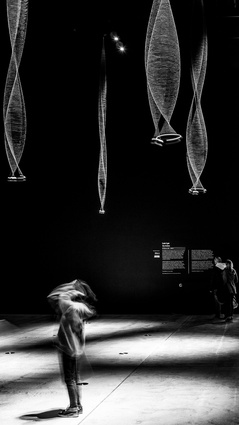Master of motion: 40 years of Len Lye
Len Lye curator at the Govett-Brewster, Paul Brobbel, looks at the acclaimed artist’s ongoing influence more than four decades after his death.
The Govett-Brewster is familiar to many as the home of Aotearoa-born film-maker and kinetic sculptor Len Lye (1901–1980). Last year, the gallery celebrated 40 years of Len Lye and five years since the opening of its Len Lye Centre extension.
The gallery’s relationship with Lye goes back to its first decade, when New Plymouth welcomed the New York-based artist back to Aotearoa in 1977 with the exhibition Len Lye: Kinetic Works. While Lye was a fierce critic of museum attitudes towards kinetic sculpture, his working relationship with the Govett-Brewster was positive and the gallery provided a desirable location for The Len Lye Foundation to deposit its collection after its formation and the artist’s death in 1980.
Following decades of annual exhibitions of Lye’s work, the Len Lye Centre (designed by Patterson Associates Architects and opened on 25 July 2015) confirmed the artist’s permanent place at the Govett-Brewster. The centre serves a deeper exploration of Lye’s art through its improved storage for the Foundation’s archive and new research, cinema and exhibition facilities.

The new exhibition spaces, with a combined volume of over 2500m3, allow for a greater exploration of Lye’s unique sense of scale. While open-air works, such as Wind Wand (2000) and Water Whirler (2006), demonstrate the monumental scale possible in Lye’s work, museum-based pieces, such as the ever-popular Trilogy (A Flip and Two Twisters, 1977), have established Lye as a master of thrilling visitors with motion they can feel in their bones. When Artforum magazine described Trilogy as “icicles tumbling down your back”, it was acclaim that went to the heart of Lye’s desires to create an empathetic response in his audience.
Since the Len Lye Centre’s opening, The Len Lye Foundation has delivered a programme of new, large-scale kinetic sculptures developed from Lye’s archive of sculptures and notes. The most recent is Sky Snakes (2020). Previously exhibited as a single work in 1965 at Buffalo’s Albright-Knox Art Gallery and the Howard Wise Gallery in New York, the new construction features six snakes arranged in a circle around a single, central snake. Each is a 4.5-metre length of ball chain spinning from a ceiling-mounted motor approximately 7.5 metres from the ground. Like Lye’s Twisters, each snake moves through a choreographed dance of harmonic shapes but without the weightiness or sense of danger. With a more delicate and ephemeral presence, Sky Snakes invites audiences into its realm, to walk under and feel the sense of motion around the human body.
As we move into a new year, another anniversary comes to mind – Lye’s debut presentation of many of his sculptures in An Evening of Tangible Motion Sculpture at the Museum of Modern Art in New York on 5 April 1961. Following just a year after fellow kinetic sculptor Jean Tinguely shocked at the same venue with his self-destructive sculpture Homage to New York, Lye’s evening was part of a moment of flourishing for the kinetic art scene. Lye’s understanding, however, that he could take his sculptural vision only so far in his own lifetime means his own moment has stretched into the 21st century, where he felt his body of work belonged.












